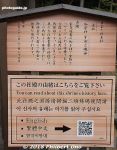 Image search results - "izumo" Image search results - "izumo" |

JR Izumo-shi Station in the 1990s.
|
|
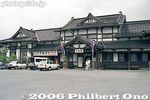
Taisha Station, closed in 1990 and preserved as an Important Cultural Property. 大社駅
|
|

Izumo Hinosaki Lighthouse 出雲日御碕燈台Went there by bicycle.
|
|

Tachikue Gorge 立久恵峡
|
|

Izumo Taisha Shrine is one of Japan's Top Three most famous and important Shinto shrines. Historically, it may be Japan's oldest shrine. The Honden hall is a National Treasure.Izumo Taisha Shrine's first torii called Otorii (Giant Torii). I visited Izumo Taisha on New Year's Day Jan. 1, 2018. 大鳥居
|
|

Sign reads, "Izumo Taisha" (出雲大社). The shrine's officially named "Izumo Oyashiro" written with the same kanji.Izumo Taisha worships Okuninushi (大国主大神), the Shinto god of marriage and Kotoamatsukami, the very first Shinto gods born in heaven even before Japan was created.
|
|

Torii pillar
|
|
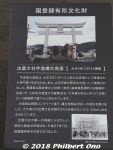
About the Otorii.
|
|

Giant torii as it looked years ago, minus the new paint job.
|
|

Closest train station to Izumo Taisha Shrine is Izumo Taisha-mae Station on the Ichibata Taisha Line. There are also buses running from Izumo-shi Station. 出雲大社前駅
|
|

Inside Izumo Taisha-mae Station on the Ichibata Taisha Line. Opened in 1930, now a Tangible Cultural Property of Japan.
|
|

Inside Izumo Taisha-mae Station.
|
|

Izumo Taisha-mae Station trains. If you're staying near Izumo-shi Station, taking a bus is more convenient.
|
|

Retro style building on the way to the shrine.
|
|

On New Year's Day 2018, cars and people crowd the road to the shrine.
|
|

Izumo, Shimane manhole. Shows Hinomisaki lighthouse.
|
|

On New Year's Day 2018, many people visit Izumo Taisha Shrine by car. Lots of parking was provided, but I always saw the "Full" sign.
|
|

This is the second and most popular torii at Izumo Taisha. With the big stone pillar engraved with "IZUMO TAISHA."
|
|

Lots of people took selfies here in front of the torii and "IZUMO TAISHA." For Instagram of course.
|
|

Lots of people took selfies here in front of the torii and big stone pillar engraved with "IZUMO TAISHA." For Instagram of course.
|
|

Lots of people took selfies here in front of the torii and big stone pillar engraved with "IZUMO TAISHA." For Instagram of course.
|
|

Sando path to the shrine. 参道
|
|

Sando path to the shrine. 参道
|
|

Sign says we are not to walk along center path in order to protect the roots of the pine trees. I'm also told that this center path is reserved for the gods visiting the shrine..
|
|

This center path is reserved for the gods visiting Izumo Taisha. Humans have to walk on the side paths to the shrine. 参道
|
|

Second torii to Izumo Taisha.
|
|

Second torii looking toward the exit.
|
|

The Sando path to the shrine is actually in the center toward the left of the photo. But they have blocked off the center path to protect the roots of the pine trees. Now thay have made concrete sidewalks outside the center path.
|
|

Approaching the third torii.
|
|

Water basin 手水舎 I got there at around 8:30 am and it wasn't so crowded. Of course, there were people, but there was no problem walking to the shrine. No stopping like at other famous shrines like Ise Jingu and Meiji Shrine on New Year's Day. Izumo Taisha was sparse in comparison.
|
|

Water basin 手水舎
|
|

Third torii made of copper and the Haiden. 碧銅の鳥居と拝殿
|
|

Izumo Taisha's Haiden worship hall where you can hold prayers and other ceremonies like in a church. Rebuilt in 1959 after the previous one was lost in a fire in 1953. 拝殿
|
|
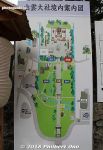
Map of Izumo Taisha Shrine. Not as huge as Ise Jingu, but large enough.
|
|
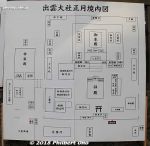
Map of Izumo Taisha's central buildings centering on the Honden.
|
|

Izumo Taisha's Haiden worship hall.
|
|

Izumo Taisha's Haiden worship hall's shimenawa sacred rope.
|
|

Haiden and shimenawa sacred rope 拝殿. The Haiden was built in 1959 after the original building was destroyed by fire in 1953.
|
|

Shimenawa sacred rope
|
|
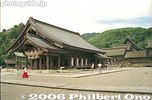
Haiden and Honden behind it.
|
|

Back of Haiden.
|
|

Gate to the Honden, the god's residence.
|
|
|

Barrels of sake decorating the perimeter near the gate to the Honden.
|
|

Gate to the Izumo Taisha Honden, the god's residence.
|
|

Emblem on the gate.
|
|

Gate to the Izumo Taisha Honden. Photography was not permitted beyond this gate. It was just a small deck with an offertory box in front of the Honden's Romon Gate. They also sold small dishes of sake.
|
|

Carvings on the Gate to the Izumo Taisha Honden.
|
|

Omikuji charms.
|
|
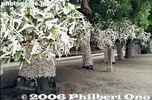
Omikuji charms.
|
|

You can walk completely around the main shrine buildings outside the fence at Izumo Taisha.
|
|

The large roof of the Honden Hall (god's residence) can be seen in the center.
|
|

The Honden is flanked on both sides by smaller shrines.
|
|

Honden (largest and tallest structure) flanked on both sides by smaller shrines.
|
|

Photo of the Izumo Taisha Honden. Built in the Taisha-zukuri style. National Treasure. 本殿
|
|

Smaller shrine. 氏社
|
|

Fence surrounding the Honden.
|
|

Izumo Taisha's Honden built in the Taisha-zukuri style as seen from the left corner. National Treasure. 本殿
|
|

Izumo Taisha's Honden built in the Taisha-zukuri style. National Treasure. 本殿
|
|

Shokokan, a museum of dolls. Tangible Cultural Property of Japan. 彰古館
|
|

Back of Izumo Taisha's Honden in the Taisha-zukuri style. National Treasure. 本殿
|
|

Back of Izumo Taisha's Honden in the Taisha-zukuri style. National Treasure. Rabbits or hares look on too. 本殿
|
|

Rabbits or hares at Izumo Taisha, symbol of fertility and marriage.
|
|

Soga Shrine, a smaller shrine behind the Honden. 素鵞(そが)社本殿
|
|

Soga Shrine, a smaller shrine behind the Honden. 素鵞(そが)社本殿
|
|

Shrine library built in 1667 and moved here in 1914. 文庫
|
|

About the shrine library. Mito Komon once donated books to this library.
|
|

Rear side view of the Amasaki-no-Yashiro, Mimukai-no-Yashiro, and Honden shrines. 東端垣から天前社・御向社・本殿を望む
|
|

Izumo Taisha's Honden, a National Treasure. The V-shaped roof ornaments (chigi), an unmistakable trademark of Shinto, also look slightly different from other shrine architectural styles.
|
|
|
|
|

Shrine priests praying in front of the Honden on New Year's Day 2018.
|
|

Signs in English including a QR code.
|
|
|
|
|
|

Taisha-zukuri architecture.
|
|
|

East Jukusha Shrines where the millions of visiting gods lodge during the Kami-ari-zuki festival in autumn. There's also a twin building on the west side. 十九社 八百萬神
|
|

Izumo Taisha has many smaller shrines surrounding it.
|
|
|
|
|

Izumo Taisha ema prayer tablets.
|
|

Izumo Taisha ema prayer tablet for the Year of the Dog.
|
|

Izumo Taisha ema prayer tablet for a good marriage.
|
|

Lots of construction going on in jan. 2018.
|
|
|
|

New shrine office under construction.
|
|

Near the gate to the Honden are souvenir tents during New Year's.
|
|
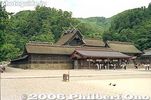
Without the tents.
|
|

West Jukusha Shrines where visiting gods lodge during the Kami-ari-zuki festival. There's also a twin building on the east side. 十九社 八百萬神
|
|

Way to the Kaguraden Sacred Dance Hall.
|
|

Kaguraden Sacred Dance Hall
|
|

Kaguraden Hall (for sacred dances) is famous for its gigantic straw rope. It looked pretty faded and I was told that it will be replaced in 2018. They replace it once every 7 years or so.
|
|
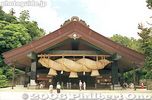
Izumo Taisha's Kaguraden with the iconic giant shimenawa sacred rope weighing 5 tons. Built in 1981. 神楽殿と注連縄
|
|

Giant shimenawa straw rope of Izumo Taisha Shrine's Kaguraden, the largest sacred rope in Japan. Weighs 5 tons.
|
|

Closeup of the giant shimenawa straw rope.
|
|

Rear side of the giant shimenawa straw rope.
|
|
|
|

Under the giant shimenawa straw rope.
|
|

Entrance to Izumo Taisha's Kaguraden.
|
|

Izumo Taisha's Kaguraden.
|
|

Izumo Taisha's Kaguraden.
|
|

Small pond next to the Kaguraden.
|
|

Small dishes for a sip of sake if you give a small donation. They also had this in front of the Honden.
|
|

Kaguraden entrance area
|
|

New Year's
|
|
|
|

Local manga figure based on the Izumo no Okuni dancer. She was from Izumo and originated kabuki in the early 17th century. 出雲阿国
|
|

Souvenir shop selling all kinds of Izumo Taisha goods.
|
|

Souvenir shop selling all kinds of Izumo Taisha goods.
|
|

Souvenir shop selling all kinds of Izumo Taisha goods.
|
|

Shimane's official tourism mascot named "Shimanekko," a yellow cat with a shrine roof cap. しまねっこ
|
|

Lawn outside Shimane Museum of Ancient Izumo.
|
|
|

New Year's kadomatsu at Shimane Museum of Ancient Izumo.
|
|
|

Shimane Museum of Ancient Izumo is celebrating its 10th anniversary in 2018.
|
|

Remains of the giant pillars of the ancient Izumo Taisha.
|
|

The museum's centerpiece exhibit is this scale model of Izumo Taisha's Honden Hall from the 10th-century Heian Period.
|
|

People believe that the original shrine was on high pillars accessible by this long, sloping wooden steps. Really awesome.
|
|
|
|
|

The elevated shrine supposed to make it closer to gods.
|
|

Little priests going up the many stairs.
|
|

Wonder how resistant this was to typhoons and earthquakes.
|
|
|
|

High wooden pillars supporting the Honden Hall so that it is closer to the gods.
|
|

Very impressive model of the shrine.
|
|

It is unknown exactly what Izumo Taisha's Honden Hall looked like during the 13th century Kamakura Period. Based on the evidence they could find, five researchers built their own scale models of what they thought the Honden Hall looked like.
|
|

The five models look quite different although they are in agreement on some things like the number of pillars supporting the Honden.
|
|

These two models are similar to the large model.
|
|

Rear view of the shrine scale models.
|
|

Rear view of the shrine scale models.
|
|
|

Models of the different shrine building architencture in Japan.
|
|
|
|

Pottery kiln
|
|

Old tsuzumi shoulder drum and koto.
|
|

Boat
|
|

Pottery
|
|
|
|

Other museum exhibits included many different ancient artifacts like dotaku bronze bells that are all National Treasures.
|
|

Dotaku bronze bells that are all National Treasures in Shimane.
|
|

Closeup of bronze bell design.
|
|
|
|
|
|

Haniwa figures
|
|
|
|
|
|

Iwami kagura dance costumes
|
|

Iwami kagura dance masks
|
|

Iwami kagura dance masks
|
|
|
|

Statue of Izumo no Okuni dancer near the first Otorii gate.
|
|
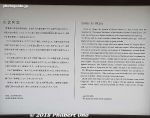
About the Izumo no Okuni dancer. Quite a mysterious historical figure.
|
|

Poster for the Katsushika Shobu (Iris) Matsuri Festival held at Mizumoto Park and Horikiri Iris Garden. 葛飾菖蒲まつり
|
|

I visited Horikiri Garden first, then dashed off to visit Mizumoto Park, a short bus ride from Kanamachi Station. From the bus stop, this little gate points the way to the park.
|
|

Central entrance to Mizumoto Park
|
|

Mizumoto Park is a huge park and the iris garden is also one of the largest.
|
|
|
|
|

Central plaza with food stalls.
|
|
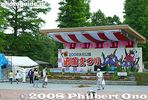
Entertainment stage (I was too late to see any entertainment.)
|
|

A wooden boardwalk is provided to view the irises.
|
|

Small signs next to the flowers indicated the flower's name.
|
|
|
|
|

Katsushika Iris Festival at Mizumoto Park in full bloom.
|
|
|
|
|
|
|
|
|
|
|
|
|
|
|
|
|
|
|
|
|
|

About Japanese irises
|
|

Paper lantern written with "Katsushika Iris Festival."
|
|
|

Panoramic shot
|
|

Former Edogawa River
|
|

Mizumoto Park also has a lotus pond.
|
|

And hydrangeas.
|
|
|
|

Tried to get irises and hydrangea in the same shot. Both flowers are associated with the month of June in most of Japan.
|
|
|

Bridge
|
|
|
|
|

The Keisei Line train also had stickers advertising the iris festival.
|
|
|
|
|


















































































